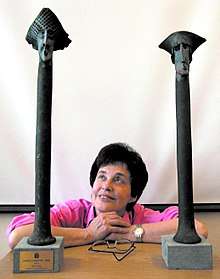Kari Hag
Kari Jorun Blakkisrud Hag (born April 4, 1941) is a Norwegian mathematician known for her research in complex analysis on quasicircles and quasiconformal mappings, and for her efforts for gender equality in mathematics. She is a professor emerita of mathematics at the Norwegian University of Science and Technology (NTNU).[1] With Frederick Gehring she is the author of the book The Ubiquitous Quasidisk (American Mathematical Society, 2012).[2]

Education and career
Hag is originally from Eidsvoll. She studied at the Norwegian School of Education in Trondheim, completing a cand.mag. in 1963, and then at the University of Oslo, completing a cand.real. in 1967.[3][4] Following this, she earned her doctorate in 1972 from the University of Michigan. Her dissertation, Quasiconformal Boundary Correspondences and Extremal Mappings, was supervised by Gehring.[5]
After completing her doctorate, she joined the Norwegian Institute of Technology (NTH), which later became part of NTNU.[4] She became a full professor at NTNU in 2001, and retired as a professor emerita in 2011.[3]
Awards and honors
NTNU gave Hag their gender equality award in 2000, for her efforts to increase the interest of girls in science and mathematics.[6] In 2018 she was elected as a knight in the Order of St. Olav.[3]
References
- Kari Hag, Norwegian University of Science and Technology, retrieved 2018-05-07
- Review of The Ubiquitous Quasidisk, Peter Haïssinsky, MR2933660
- Normannsen, Sølvi Waterloo (April 17, 2018), "Matematiker Kari Hag blir ridder av St. Olavs orden", Universitetsavisa (in Norwegian)
- Rabben, Magne Brekke (April 30, 2018), "Kari Hag", Store norske leksikon, retrieved 2018-05-07
- Kari Hag at the Mathematics Genealogy Project
- Likestillingspris 2000 (in Norwegian), Norwegian University of Science and Technology, 2000, retrieved 2018-05-07